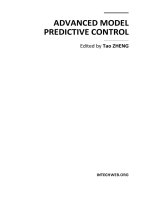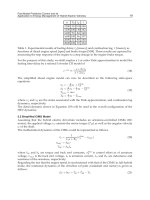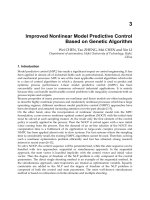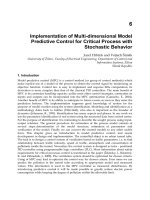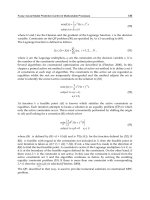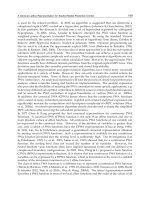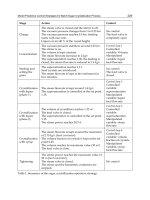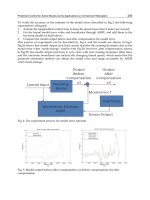Advanced Model Predictive Control Part 1 docx
Bạn đang xem bản rút gọn của tài liệu. Xem và tải ngay bản đầy đủ của tài liệu tại đây (696.66 KB, 30 trang )
ADVANCEDMODEL
PREDICTIVECONTROL
EditedbyTaoZHENG
Advanced Model Predictive Control
Edited by Tao ZHENG
Published by InTech
Janeza Trdine 9, 51000 Rijeka, Croatia
Copyright © 2011 InTech
All chapters are Open Access articles distributed under the Creative Commons
Non Commercial Share Alike Attribution 3.0 license, which permits to copy,
distribute, transmit, and adapt the work in any medium, so long as the original
work is properly cited. After this work has been published by InTech, authors
have the right to republish it, in whole or part, in any publication of which they
are the author, and to make other personal use of the work. Any republication,
referencing or personal use of the work must explicitly identify the original source.
Statements and opinions expressed in the chapters are these of the individual contributors
and not necessarily those of the editors or publisher. No responsibility is accepted
for the accuracy of information contained in the published articles. The publisher
assumes no responsibility for any damage or injury to persons or property arising out
of the use of any materials, instructions, methods or ideas contained in the book.
Publishing Process Manager Romina Krebel
Technical Editor Teodora Smiljanic
Cover Designer Jan Hyrat
Image Copyright alphaspirit, 2010. Used under license from Shutterstock.com
First published June, 2011
Printed in Croatia
A free online edition of this book is available at www.intechopen.com
Additional hard copies can be obtained from
Advanced Model Predictive Control, Edited by Tao ZHENG
p. cm.
ISBN 978-953-307-298-2
free online editions of InTech
Books and Journals can be found at
www.intechopen.com
Contents
Preface IX
Part 1 New Theory of Model Predictive Control 1
Chapter 1 Fast Model Predictive Control and its Application
to Energy Management of Hybrid Electric Vehicles 3
Sajjad Fekri and Francis Assadian
Chapter 2 Fast Nonlinear Model Predictive Control
using Second Order Volterra Models
Based Multi-agent Approach 29
Bennasr Hichem and M’Sahli Faouzi
Chapter 3 Improved Nonlinear Model Predictive Control
Based on Genetic Algorithm 49
Wei Chen, Zheng Tao, Chen Mei and Li Xin
Chapter 4 Distributed Model Predictive Control
Based on Dynamic Games 65
Guido Sanchez, Leonardo Giovanini,
Marina Murillo and Alejandro Limache
Chapter 5 Efficient Nonlinear Model Predictive Control
for Affine System 91
Tao Zheng and Wei Chen
Chapter 6 Implementation of Multi-dimensional
Model Predictive Control for Critical Process
with Stochastic Behavior 109
Jozef Hrbček and Vojtech Šimák
Chapter 7 Fuzzy–neural Model Predictive Control
of Multivariable Processes 125
Michail Petrov, Sevil Ahmed,
Alexander Ichtev and Albena Taneva
VI Contents
Chapter 8 Using Subsets Sequence to Approach
the Maximal Terminal Region for MPC 151
Yafeng Wang, Fuchun Sun, Youan Zhang,
Huaping Liu and Haibo Min
Chapter 9 Model Predictive Control for Block-oriented
Nonlinear Systems with Input Constraints 163
Hai-Tao Zhang
Chapter 10 A General Lattice Representation
for Explicit Model Predictive Control 197
Chengtao Wen and Xiaoyan Ma
Part 2 Successful Applications of Model Predictive Control 223
Chapter 11 Model Predictive Control Strategies
for Batch Sugar Crystallization Process 225
Luis Alberto Paz Suárez, Petia Georgieva
and Sebastião Feyo de Azevedo
Chapter 12 Predictive Control for Active Model
and Its Applications on Unmanned Helicopters 245
Dalei Song, Juntong Qi, Jianda Han and Guangjun Liu
Chapter 13 Nonlinear Autoregressive with Exogenous Inputs
Based Model Predictive Control for Batch
Citronellyl Laurate Esterification Reactor 267
Siti Asyura Zulkeflee, Suhairi Abdul Sata and Norashid Aziz
Chapter 14 Using Model Predictive Control
for Local Navigation of Mobile Robots 291
Lluís Pacheco, Xavier Cufí and Ningsu Luo
Chapter 15 Model Predictive Control and Optimization
for Papermaking Processes 309
Danlei Chu, Michael Forbes, Johan Backström,
Cristian Gheorghe and Stephen Chu
Chapter 16 Gust Alleviation Control Using Robust MPC 343
Masayuki Sato, Nobuhiro Yokoyama and Atsushi Satoh
Chapter 17 MBPC – Theoretical Development
for Measurable Disturbances
and Practical Example of Air-path in a Diesel Engine 369
Jose Vicente García-Ortiz
Chapter 18 BrainWave®: Model Predictive Control
for the Process Industries 393
W. A (Bill) Gough
Preface
Since the earliest algorithm of Model Predictive Control was proposed by French
engineer Richalet and his colleagues in 1978, the explicit background of industrial
application has made MPC develop rapidly. Different from most other control
algorithms, theresearchtrajectoryofMPCisoriginated fromengineeringapplication
and then expanded to theoretical fi
eld, while ordinary control algorithms often have
applicationsaftersufficienttheoreticalwork.
Nowadays, MPC is not just the name of one or some specific computer control
algorithms, but the name of a specific controller design thought, which can derive
many kinds of MPC controllers for almost all kinds of systems, linear or nonlinear,
c
ontinuous or discrete, integrated or distributed. However, the basic characters of
MPC canbesimply summarized as a model used for prediction, online optimization
basedonpredictionandfeedbackcompensation,whilethereisnospecialdemandon
theformof thesystemmodel,the computationaltoolforonlineoptimizationandthe
formoffeedbackcompensation.
ThelinearMPCtheoryisnowcomparativelymature,soitsapplicationscanbefound
inalmosteverydomaininmodernengineering. Butrobust MPCandnonlinearMPC
(NMPC)arestillproblemsforus.Thoughtherearesomeconstructiveresultsbecause
many efforts have been mad
e on them in these years, they will remain the focus of
MPCresearchforalongperiodinthefuture.
In the first part of this book, to present recent theoretical developments of MPC,
Chapter 1 to Chapter 3 introduce three kinds of Fast Model Predictive Control, and
Chapter4presentsMode
lPredictiveControlfordistributedsystems.ModelPredictive
Control for nonlinear systems, multi‐variable systems and other special model are
proposedinChapters5through10.
To give the readers successful examples of MPC’s recent applications, in the second
part of the book, Chapters 11 through 18 introduce some of them, from sugar
crystallization process to paper‐making system, from linear system to nonlinear
system. They can, not only help the readers understand the characteristics of MPC
more clearly, but also give them guidance how to use MPC to solve practical
problems.
X Preface
Authorsofthis booktrulywa ntit tobehelpfulforresearchersandstudentswhoare
concerned about MPC, and further discussions on the contents of this book are
warmlywelcome.
Finally,thanksto InTechand itsofficersfor theireffortsinthe processofeditionand
publication, and thanks to all the people wh
o have made contributes to this book,
includingourdearfamilymembers.
ZHENGTao
HefeiUniversityofTechnology,
China
Part 1
New Theory of Model Predictive Control
0
Fast Model Predictive Control and its Application
to Energy Management of Hybrid
Electric Vehicles
Sajjad Fekri and Francis Assadian
Automotive Mechatronics Centre, Department of Automotive Engineering
School of Engineering, Cranfield University
UK
1. Introduction
Modern day automotive engineers are required, among other objectives, to maximize fuel
economy and to sustain a reasonably responsive car (i.e. maintain driveability) while still
meeting increasingly stringent emission constraints mandated by the government. Towards
this end, Hybrid Electric Vehicles (HEVs) have been introduced which typically combine two
different sources of power, the traditional internal combustion engine (ICE) with one (or more)
electric motors, mainly for optimising fuel efficiency and reducing Carbon Dioxide (CO
2
)and
greenhouse gases (GHG) (Fuhs, 2008).
Compared to the vehicles with conventional ICE, hybrid propulsion systems are potentially
capable of improving fuel efficiency for a number of reasons: they are able to recover some
portion of vehicle kinetic energy during braking and use this energy for charging the battery
and hence, utilise the electric motor at a later point in time as required. Also, if the torque
request (demanded by driver) is below a threshold torque, the ICE can be switched off as well
as during vehicle stop for avoiding engine idling. These are in fact merely few representative
advantages of the hybrid vehicles compared to those of conventional vehicles. There are also
other benefits hybrid electric vehicles could offer in general, e.g. engine downsizing and
utilising the electric motor/motors to make up for the lost torque. It turns out that the internal
combustion engine of the hybrid electric vehicle can be potentially designed with a smaller
size and weight which results in higher fuel efficiency and lower emissions (Steinmaurer &
Del Re, 2005).
Hybrid electric vehicles have been received with great enthusiasm and attention in recent
years (Anderson & Anderson, 2009). On the other hand, complexity of hybrid powertrain
systems have been increased to meet end-user demands and to provide enhancements to fuel
efficiency as well as meeting new emission standards (Husain, 2003).
The concept of sharing the requested power between the internal combustion engine and
electric motor for traction during vehicle operation is referred to as "vehicle supervisory
control" or "vehicle energy management" (Hofman & Druten, 2004). The latter term, employed
throughout this chapter, is particularly referred to as a control allocation for delivering the
required wheel torque to maximize the average fuel economy and sustain the battery state of
charge (SoC) within a desired charging range (Fekri & Assadian, 2011).
1
2 Will-be-set-by-IN-TECH
The vehicle energy management development is a challenging practical control problem and
a significant amount of research has been devoted to this field for full HEVs and Electric
Vehicles (EVs) in the last decade (Cundev, 2010). To tackle this challenging problem, there are
currently extensive academic and industrial research interests ongoing in the area of hybrid
electric vehicles as these vehicles are expected to make considerable contributions to the
environmentally conscious requirements in the production vehicle sector in the future – see
(Baumann et al., 2000) and other references therein.
In this regard, we shall analysis and extend the study done by (Sciarretta & Guzzella, 2007)
on the number of IEEE publications published between 1985 and 2010. Figure 1 depicts the
number of publications recorded at the IEEE database
1
whose abstract contains at least one of
the strings "hybrid vehicle" or "hybrid vehicles".
From Figure 1, it is obvious that the number of publications in the area of hybrid electric
vehicles (HEVs) has been drastically increased during this period, from only 2 papers in
1985 to 552 papers in 2010. Recall that these are only publications of the IEEE database -
there are many other publications than those of the IEEE including books, articles, conference
papers, theses, filed patents, and technical reports which have not been taken into account in
this study. Besides, a linear regression analysis of the IEEE publications shown in Figure 1
indicates that research in the field of hybrid vehicles has been accelerated remarkably since
2003. One may also predict that the number of publications in this area could be increased up
to about 1000 articles in 2015, that is nearly twice as many as in 2010 - this is a clear evidence
to acknowledge that HEVs research and development is expected to make considerable
contributions to both academia and industry of production automotive sector in the future.
1985 1990 1995 2000 2005 2010
0
100
200
300
400
500
600
Year
No. of Publications
Actual Data
Linear Fitting
Fig. 1. Hybrid vehicle research trend based on the number of publications of the IEEE over
the period 1985 to 2010.
Here are the facts and regulations which must be taken into consideration by automotive
engineers:
• Due to the ever increasing stringent regulations on fuel consumption and emissions,
there are tremendous mandates on Original Equipment Manufacturers (OEMs) to deliver
fuel-efficient less-polluting vehicles at lower costs. Hence, the impact of advanced controls
for the application of the hybrid vehicle powertrain controls has become extremely
important (Fekri & Assadian, 2011).
1
See for more information.
4
Advanced Model Predictive Control
Fast Model Predictive Control and its Application to Energy Management of Hybrid Electric Vehicles 3
• It is essential to meet end-user demands for increasingly complex new vehicles towards
improving vehicle performance and driveability (Cacciatori et al., 2006), while continuing
to reduce costs and meeting new emission standards.
• There is a continuous increase in the gap between the theoretical control advancement
and the control strategies being applied to the existing production vehicles. This
gap is resulting on significant missed opportunities in addressing some fundamental
functionalities, e.g. fuel economy, emissions, driveability, unification of control
architecture and integration of the Automotive Mechatronics units on-board vehicle. It
seems remarkably vital to address how to bridge this gap.
• Combined with ever-increasing computational power, fast online optimisation algorithms
are now more affordable to be developed, tested and implemented in the future production
vehicles.
There are a number of energy management methods proposed in the literature of hybrid
vehicles to minimize fuel consumption and to reduce CO
2
emissions (Johnson et al., 2000).
Among these energy management strategies, a number of heuristics techniques, say e.g. using
rule-based or Fuzzy logic, have attempted to offer some improvements in the HEV energy
efficiency (Cikanek & Bailey, 2002; Schouten et al., 2002) where the optimisation objective is, in
a heuristic manner, a function of weighted fuel economy and driveability variables integrated
with a performance index, to obtain a desired closed-loop system response. However, such
heuristics based energy management approaches suffer from the fact that they guarantee
neither an optimal result in real vehicle operational conditions nor a robust performance
if system parameters deviate from their nominal operating points. Consequently, other
strategies have emerged that are based on optimisation techniques to search for sub-optimal
solutions. Most of these control techniques are based on programming concepts (such
as linear programming, quadratic programming and dynamic programming) and optimal
control concepts, to name but a few (Ramsbottom & Assadian, 2006; Ripaccioli et al., 2009;
Sciarretta & Guzzella, 2007). Loosely speaking, these techniques do not offer a feasible casual
solution, as the future driving cycle is assumed to be entirely known. Moreover, the required
burdensome calculations of these approaches put a high demand on computational resources
which prevent them to be implemented on-line in a straightforward manner. Nevertheless,
their results could be used as a benchmark for the performance of other strategies, or to derive
rules for rule-based strategies for heuristic based energy management of HEVs (Khayyam et
al., 2010).
Two new HEV energy management concepts have been recently introduced in the literature.
In the first approach, instead of considering one specific driving cycle for calculating
an optimal control law, a set of driving cycles is considered resulting in the stochastic
optimisation approach. A solution to this approach is calculated off-line and stored in
a state-dependent lookup table. Similar approach in this course employs Explicit Model
Predictive Control (Beccuti et al., 2007; Pena et al., 2006). In this design methodology, the entire
control law is computed offline, where the online controller will be implemented as a lookup
table, similar to the stochastic optimisation approach. The lookup table provides a quasi-static
control law which is directly applicable to the on-line vehicle implementation. While this
method has potential to perform well for systems with fewer states, inputs, constraints, and
"sufficiently short" time-horizons (Wang & Boyd, 2008), it cannot be utilised in a wide variety
of applications whose dynamics, cost function and/or constraints are time-varying due to e.g.
5
Fast Model Predictive Control and its
Application to Energy Management of Hybrid Electric Vehicles
4 Will-be-set-by-IN-TECH
parametric uncertainties and/or unmeasurable exogenous disturbances. In other words, any
lookup table based optimisation approach may end up with severe difficulties in covering
a real-world driving situation with a set of individual driving cycle. A recent approach has
endeavored to decouple the optimal solution from a driving cycle in a game-theoretic (GT)
framework (Dextreit et al., 2008). In this approach, the effect of the time-varying parameters
(namely drive cycle) is represented by the actions of the first player while the effect of the
operating strategy (energy management) is modeled by the actions of the second player.
The first player (drive cycle) wishes to maximize the performance index which reflects the
optimisation objectives, say e.g. to minimise emission constraints and fuel consumption,
while the second player aims to minimize this performance index. Solutions to these
approaches are calculated off-line and stored in a state-dependent lookup tables. These look
up tables provide a quasi-static control law which is directly suitable for on-line vehicle
implementation. Similar to previous methods, the main drawbacks of the game-theoretic
approach are the lack of robustness and due to quasi-static nature of this method, it cannot
address vehicle deriveability requirements.
If only the present state of the vehicle is considered, optimisation of the operating points of
the individual components can still be beneficial. Typically, the proposed methods define
an optimisation criterion to minimise the vehicle fuel consumption and exhaust emissions
(Kolmanovsky et al., 2002). A weighting factor can be included to prevent a drift in the
battery from its nominal energy level and to guarantee a charge sustaining solution. This
approach has been considered in the past, but it is still remained immensely difficult task to
select a weighting factor that is mathematically sound (Rousseau et al., 2008). An alternative
approach is to extend the objective function with a fuel equivalent term. This term includes the
corresponding fuel use for the energy exchange with the battery in the optimisation criterion
(Kessels, 2007).
Hybrid modeling tools have been recently developed to analyse and optimise a number of
classes of hybrid systems. Among many other modeling tools developed to represent the
hybrid systems, we shall refer to Mixed Logical Dynamical (MLD) (Bemporad & Morary,
1999), HYbrid Systems Description Language (HYSDEL) (Torrisi & Bemporad, 2004), and
Piecewise Affine (PWA) models (Ripaccioli et al., 2009; Sontag, 1981), to name but a few.
In addition, Hybrid Toolbox for MATLAB (Bemporad, 2004) is developed for modeling,
simulation, and verifying hybrid dynamical models and also for designing hybrid model
predictive controllers. Almost all of these hybrid tools, however, are only suitable for slow
applications and can not attack the challenging fast real-time optimisation problems, e.g., for
the use of practical hybrid electric vehicle energy management application.
Two fundamental drawbacks of aforementioned strategies are firstly their consideration of
driveability being an afterthought and secondly the driveability issue is considered in an
ad-hoc fashion as these approaches are not model-based dynamic. Applicable techniques
such as game-theoretic based optimisation method utilise quasi-static models which are not
sufficient to address driveability requirements (Dextreit et al., 2008).
Towards a feasible and tractable optimisation approach, there are a number of model-based
energy management methods such as Model Predictive Controls (MPC). A recently developed
package for the hybrid MPC design is referred to as Hybrid and Multi-Parametric Toolboxes
(Narciso et al., 2008) which is based on the traditional model predictive control optimisation
alternatives using generic optimisers. The main shortcoming of traditional model predictive
control methods is that they can only be used in applications with "sufficiently slow" dynamics
6
Advanced Model Predictive Control
Fast Model Predictive Control and its Application to Energy Management of Hybrid Electric Vehicles 5
(Wang & Boyd, 2008), and hence are not suitable for many practical applications including
HEV energy management problem. For this reason the standard MPC algorithms have been
retained away from modern production vehicles. In fact, a number of inherent hardware
constraints and limitations integrated with the vehicle electronic control unit (ECU), such
as processing speed and memory, have made on-line implementations of these traditional
predictive algorithms almost impossible. In a number of applications, MPC is currently
applied off-line to generate the required maps and then these maps are used on-line. However,
generation and utilisation of maps defeat the original purpose of designing a dynamic
compensator which maintains driveability. Therefore, there is a vital need of increased
processing speed, with an appropriate memory size, so that an online computation of "fast
MPC" control law could be implemented in real applications.
In this chapter, we shall describe a method for improving the speed of conventional model
predictive control design, using online optimisation. The method proposed would be a
complementary for offline methods, which provide a method for fast control computation
for the problem of energy management of hybrid electric vehicles. We aim to design and
develop a practical fast model predictive feedback controller (FMPC) to replace the current
energy management design approaches as well as to address vehicle driveability issues.
The proposed FMPC is derived based on the dynamic models of the plant and hence
driveability requirements are taken into consideration as part of the controller design. In
this development, we shall extend the previous studies carried out by Stephen Boyd and his
colleagues at Stanford University, USA, on fast model predictive control algorithms. In this
design, we are also able to address customising the robustness analysis in the presence of
parametric uncertainties due to, e.g., a change in the dynamics of the plant, or lack of proper
estimation of the vehicle load torque (plant disturbance).
In this chapter, we shall also follow and overview some of theoretical and practical aspects
of the fast online model predictive control in applying to the practical problem of hybrid
electric vehicle energy management along with representing some of simulation results. The
novelty of this work is indeed in the design and development of the fast robust model
predictive control concept with practical significance of addressing vehicle driveability and
automotive actuator control constraints. It is hoped that the results of this work could make
automotive engineers more enthusiastic and motivated to keep an eye on the development
of state-of-the-art Fast Robust Model Predictive Control (FMPC) and its potential to attack a
wide range of applications in the automotive control system designs.
In the remaining of this chapter, we will describe in detail the mathematical description,
objectives and constraints along with the optimisation procedure of the proposed fast model
predictive control. We shall also provide dynamical model of the hybrid electric vehicle
(parallel, with diesel engine) to which the FMPC will be applied. Simulation results of the
HEV energy management system will be demonstrated to highlight some of the concepts
proposed in this chapter which will offer significant improvements in fuel efficiency over the
base system.
2. Fast Model Predictive Control
The Model Predictive Control (MPC), referred also to as Receding Horizon Control (RHC),
and its different variants have been successfully implemented in a wide range of practical
applications in industry, economics, management and finance, to name a few (Camacho &
7
Fast Model Predictive Control and its
Application to Energy Management of Hybrid Electric Vehicles
6 Will-be-set-by-IN-TECH
Bordons, 2004; Maciejowski, 2002). A main advantage of MPC algorithms, which has made
these optimisation-based control system designs attractive to the industry, is their abilities to
handle the constraints directly in the design procedure (Kwon & Han, 2005). These constraints
may be imposed on any part of the system signals, such as states, outputs, inputs, and most
importantly actuator control signals which play a key role in the closed-loop system behaviour
(Tate & Boyd, 2001).
Although very efficient algorithms can currently be applied to some classes of practical
problems, the computational time required for solving the optimisation problem in real-time
is extremely high, in particularly for fast processes, such as energy management of hybrid
electric vehicles. One method to implement a fast MPC is to compute the solution of a
multiparametric quadratic or linear programming problem explicitly as a function of the
initial state which could turn into a relatively easy-to-implement piecewise affine controller
(Bemporad et al., 2002; Tondel et al., 2003). However, as the control action implemented
online is in the form of a lookup table, it could exponentially grow with the horizon, state
and input dimensions. This means that any form of explicit MPC could only be applied to
small problems with few state dimensions (Milman & Davidson, 2003). Furthermore, due to
there being off-line lookup table, explicit MPC cannot deal with applications whose dynamics,
cost function and/or constraints are time-varying (Wang & Boyd, 2008). A non-feasible
active set method was proposed in (Milman & Davidson, 2003) for solving the Quadratic
Programming (QP) optimisation problem of the MPC. However, to bear further explanation,
these studies have not addressed any comparison to the other earlier optimisation methods
using primal-dual interior point methods (Bartlett et al., 2000; Rao et al., 1998). Another
fast MPC strategy was introduced in (Wang & Boyd, 2010) which has tackled the problem
of solving a block tridiagonal system of linear equations by coding a particular structure of
the QPs arising in MPC applications (Vandenberghe & Boyd, 2004; Wright, 1997), and by
solving the problem approximately. Starting from a given initial state and input trajectory,
the fast MPC software package solves the optimization problem fast by exploiting its special
structure. Due to using an interior-point search direction calculated at each step, any problem
of any size (with any number of state dimension, input dimension, and horizon) could be
tackled at every operational time step which in return will require only a limited number of
steps. Therefore, the complexity of MPC is significantly reduced compared to the standard
MPC algorithms. While this algorithm could be scaled in any problem size in principle, a
drawback of this method is that it is a custom hand-coded algorithm, ie. the user should
transform their problem into the standard form (Wang & Boyd, 2010; 2008) which might be
very time-consuming. Moreover, one may require much optimisation expertise to generate a
custom solver code. To overcome this shortcoming, a very recent research (Mattingley & Boyd,
2010a;b; 2009) has studied a development of an optimisation software package, referred to as
CVXGEN, based on an earlier work by (Vandenberghe, 2010), which automates the conversion
process, allowing practitioners to apply easily many class of convex optimisation problem
conversions. CVXGEN is effectively a software tool which helps to specify one’s problem
in a higher level language, similar to other parser solvers such as SeDuMi or SDPT3 (Ling
et al., 2008). The drawback of CVXGEN is that it is limited to optimization problems with
up to around 4000 non-zero Karush-Kuhn-Tucker (KKT) matrix entries (Mattingley & Boyd,
2010b). In the next section, we will extend the work done by (Mattingley & Boyd, 2010b) and
propose a new fast KKT solving approach, which alleviates the aforementioned limitation to
8
Advanced Model Predictive Control
Fast Model Predictive Control and its Application to Energy Management of Hybrid Electric Vehicles 7
some extent. We will implement our method on a hybrid electric vehicle energy management
application in Section 4.
2.1 Quadratic Programming (QPs)
In convex QP problems, we typically minimize a convex quadratic objective function subject
to linear (equality and/or inequality) constraints. Let us assume a convex quadratic
generalisation of the standard form of the QP problem is
min
(1/2)x
T
Qx + c
T
x
subject to Gx
≤ h,
Ax
= b .
(1)
where x
∈ R
n
is the variable of the QP problem and Q is a symmetric n × n positive
semidefinite matrix.
An interior-point method, in comparison to other methods such as primal barrier method, is
particularly appropriate for embedded optimization, since, with proper implementation and
tuning, it can reliably solve to high accuracy in 5-25 iterations, without even a "warm start"
(Wang & Boyd, 2010).
In order to obtain a cone quadratic program (QP) using the QP optimisation problem of
Equation (1), it is expedient for the analysis and implementation of interior-point methods
to include a slack variable s and solve the equivalent QP
min
(1/2)x
T
Qx + c
T
x
subject to Gx
+ s = h,
Ax
= b ,
s
≥ 0.
(2)
where x
∈ R
n
and s ∈ R
p
are the variables of the cone QP problem.
The dual problem of Equation (3) can be simply derived by introducing an additional variable
ω: (Vandenberghe, 2010)
max
− (1/2)ω
T
Qω − h
T
z − b
T
y
subject to G
T
z + A
T
y + c + Qω = 0,
z
≥ 0.
(3)
where y
∈ R
m
and z ∈ R
p
are the Lagrange multiplier vectors for the equality and the
inequality constraints of (1), respectively.
The dual objective of (3) provides a lower bound on the primal objective, while the primal
objective of (1) gives an upper bound on the dual (Vandenberghe & Boyd, 2004). The vector
x
∗
∈ R
n
is an optimal solution of Equation (1) if and only if there exist Lagrange multiplier
vectors z
∗
∈ R
p
and y
∗
∈ R
m
for which the following necessity KKT conditions hold for
(x, y, z)=(x
∗
, y
∗
, z
∗
); see (Potra & Wright, 2000) and other references therein for more details.
9
Fast Model Predictive Control and its
Application to Energy Management of Hybrid Electric Vehicles
8 Will-be-set-by-IN-TECH
F(x, y, z, s)=
⎡
⎢
⎢
⎣
Qx
+ A
T
y + G
T
z + c
Ax
− b
Gx
+ s − h
ZSe
⎤
⎥
⎥
⎦
= 0,
(s, z) ≥ 0
(4)
where S
= diag(s
1
, s
2
, ,s
n
), Z = diag (z
1
, z
2
, ,z
n
) and e is the unit column vector of size
n
× 1.
The primal-dual algorithms are modifications of Newton’s method applied to the KKT
conditions F
(x, y, z, s)=0 for the nonlinear equation of Equation (4). Such modifications lead
to appealing global convergence properties and superior practical performance. However,
they might interfere with the best-known characteristic of the Newton’s method, that is "fast
asymptotic convergence" of Newton’s method. In any case, it is possible to design algorithms
which recover such an important property of fast convergence to some extent, while still
maintaining the benefits of the modified algorithm (Wright, 1997). Also, it is worthwhile to
emphasise that all primal-dual approaches typically generate the iterates
(x
k
, y
k
, z
k
, s
k
) while
satisfying nonnegativity condition of Equation (4) strictly, i.e. s
k
> 0andz
k
> 0. This
particular property is in fact the origin of the generic term "interior-point" (Wright, 1997)
which will be briefly discussed next.
2.2 Embedded QP convex optimisation
There are several numerical approaches to solve standard cone QP problems. One alternative
which seems suitable to the literature of fast model predictive control is the path-following
algorithm – see e.g. (Potra & Wright, 2000; Renegar & Overton, 2001) and other references
therein.
In the path-following method, the current iterates are denoted by
(x
k
, y
k
, z
k
, s
k
) while the
algorithm is started at initial values
(x
k
, y
k
, z
k
, s
k
)=(x
0
, y
0
, z
0
, s
0
) where (s
0
, z
0
) > 0. For
most problems, however, a strictly feasible starting point might be extremely difficult to find.
Although it is straightforward to find a strictly feasible starting point by reformulating the
problem – see (Vandenberghe, 2010, §5.3)), such reformulation may introduce distortions that
can potentially make the problem harder to solve due to an increased computational time to
generate real-time control law which is not desired for a wide range of practical applications,
e.g. the HEV energy management problem – see Section 4. In §2.4, we will describe one
tractable approach to obtain such feasible starting points.
Similar to many other iterative algorithms in nonlinear programming and optimisation
literature, the primal-dual interior-point methods are based on two fundamental concepts:
First, they contain a procedure for determining the iteration step and secondly they are
required to define a measure of the attraction of each point in the search space. The utilised
Newton’s method in fact forms a linearised model for F
(x, y, z, s) around the current iteration
point and obtains the search direction
(Δx, Δy, Δz, Δs) by solving the following set of linear
equations:
J
(x, y, z, s)
⎡
⎢
⎢
⎣
Δ
x
Δ
y
Δ
z
Δ
k
⎤
⎥
⎥
⎦
= −F(x, y, z, s) (5)
10
Advanced Model Predictive Control
Fast Model Predictive Control and its Application to Energy Management of Hybrid Electric Vehicles 9
where J is the Jacobian of F at point (x
k
, y
k
, z
k
, s
k
).
Let us assume that the current point is strictly feasible. In this case, a Newton "full step" will
provide a direction at
⎡
⎢
⎢
⎣
QA
T
G
T
0
A 000
G 00I
00 SZ
⎤
⎥
⎥
⎦
⎡
⎢
⎢
⎣
Δx
k
Δy
k
Δz
k
Δs
k
⎤
⎥
⎥
⎦
= −F(x
k
, y
k
, z
k
, s
k
) (6)
and the next starting point for the algorithm will be
(x
k+1
, y
k+1
, z
k+1
, s
k+1
)=(x
k
+ Δx
k
, y
k
+ Δy
k
, z
k
+ Δz
k
, s
k
+ Δs
k
)
However, the pure Newton’s method, i.e. a full step along the above direction, could often
violate the condition
(s, z) > 0 – see (Renegar & Overton, 2001). To resolve this shortcoming,
a line search along the Newton direction is in a way that the new iterate will be (Wright, 1997)
(x
k
, y
k
, z
k
, s
k
)+α
k
(Δx
k
, Δy
k
, Δz
k
, Δs
k
)
for some line search parameter α ∈ (0,1].Ifα is to be selected by user, one could only take a
small step
(α 1) along the direction of Equation (6) before violating the condition (s, z) > 0.
However, selecting such a small step is not desirable as this may not allow us to make much
progress towards a sound solution to a broad range of practical problems which usually are
in need of fast convenance by applying "sufficiently large" step sizes.
Following the works (Mattingley & Boyd, 2010b) and (Vandenberghe, 2010), we shall intend
to modify the basic Newton’s procedure by two scaling directions (i.e. affine scaling
and combined centering & correction scaling). Loosely speaking, by using these two
scaling directions, it is endeavoured to bias the search direction towards the interior of the
nonnegative orthant
(s, z) > 0 so as to move further along the direction before one of
the components of
(s, z) becomes negative. In addition, these scaling directions keep the
components of
(s, z) from moving "too close" to the boundary of the nonnegative orthant
(s, z) > 0. Search directions computed from points that are close to the boundary tend to be
distorted from which an inferior progress could be made along those points – see (Wright,
1997) for more details. Here, we shall list the scaling directions as follows.
2.3 Scaling iterations
We follow the works by (Vandenberghe, 2010, §5.3) and (Mattingley & Boyd, 2010b) with
some modifications that reflect our notation and problem format. Starting at initial values
(
ˆ
x,
ˆ
y,
ˆ
z,
ˆ
s
)=(x
0
, y
0
, z
0
, s
0
) where s
0
> 0, z
0
> 0, we consider the scaling iterations as
summarised here.
•Step1.Setk
= 0.
• Step 2. Start the iteration loop at time step k.
• Step 3. Define the residuals for the three linear equations as:
⎡
⎣
r
x
r
y
r
z
⎤
⎦
=
⎡
⎣
0
0
ˆ
s
⎤
⎦
+
⎡
⎣
QA
T
G
T
A 00
G 00
⎤
⎦
⎡
⎣
ˆ
x
ˆ
y
ˆ
z
⎤
⎦
+
⎡
⎣
c
−b
−h
⎤
⎦
11
Fast Model Predictive Control and its
Application to Energy Management of Hybrid Electric Vehicles
10 Will-be-set-by-IN-TECH
• Step 4. Compute the optimality conditions:
⎡
⎣
0
0
s
⎤
⎦
=
⎡
⎣
QA
T
G
T
−A 00
−G 00
⎤
⎦
⎡
⎣
x
y
z
⎤
⎦
+
⎡
⎣
c
b
h
⎤
⎦
,
(s, z) ≥ 0.
• Step 5. If the optimality conditions obtained at Step 4 satisfy
(x, y, z, s) − (
ˆ
x,
ˆ
y,
ˆ
z,
ˆ
s
)
∞
≤ ,
for some small positive
> 0, go to Step 13.
• Step 6. Solve the following linear equations to generate the affine direction (Mattingley &
Boyd, 2010b):
⎡
⎢
⎢
⎣
QA
T
G
T
0
A 000
G 00I
00 SZ
⎤
⎥
⎥
⎦
⎡
⎢
⎢
⎢
⎢
⎣
Δx
aff
k
Δy
aff
k
Δz
aff
k
Δs
aff
k
⎤
⎥
⎥
⎥
⎥
⎦
= −F(x
k
, y
k
, z
k
, s
k
) (7)
• Step 7. Compute the duality measure μ,stepsizeα
∈ (0, 1], and centering parameter
σ
∈ [0, 1]
μ =
1
n
n
∑
i=1
s
i
z
i
=
z
T
s
n
σ =
(s+α
c
Δs
af f
)
T
(z+α
c
Δz
af f
)
s
T
z
3
and
α
c
= sup{α ∈ [0, 1]|(s + α
c
Δs
aff
, z + α
c
Δz
aff
) ≥ 0}
• Step 8. Solve the following linear equations for the combined centering-correction
direction
2
:
⎡
⎢
⎢
⎣
QA
T
G
T
0
A 000
G 00I
00 SZ
⎤
⎥
⎥
⎦
⎡
⎢
⎢
⎣
Δx
cc
Δy
cc
Δz
cc
Δs
cc
⎤
⎥
⎥
⎦
=
⎡
⎢
⎢
⎣
0
0
0
σμe
− diag(Δs
aff
)Δz
aff
⎤
⎥
⎥
⎦
This system is well defined if and only if the Jacobian matrix within is nonsingular (Peng
et al., 2002, §6.3.1).
• Step 9. Combine the two affine and combined updates of the required direction as:
Δx
= Δx
aff
+ Δx
cc
Δy = Δy
aff
+ Δy
cc
Δz = Δz
aff
+ Δz
cc
Δs = Δs
aff
+ Δs
cc
• Step 10. Find the appropriate step size to retain nonnegative orthant (s, z) > 0,
α
= min{1, 0.99 sup(α ≥ 0|(s + αΔs, z + αΔz) ≥ 0) }
2
This is another variant of Mehrotra’s predictor-corrector algorithm (Mehrotra, 1992), a primal-dual
interior-point method, which yields more consistent performance on a wide variety of practical
problems.
12
Advanced Model Predictive Control
Fast Model Predictive Control and its Application to Energy Management of Hybrid Electric Vehicles 11
• Step 11. Update the primal and dual variables using:
⎡
⎢
⎢
⎣
x
y
z
s
⎤
⎥
⎥
⎦
:
=
⎡
⎢
⎢
⎣
x
y
z
s
⎤
⎥
⎥
⎦
+ α
⎡
⎢
⎢
⎣
Δx
Δy
Δz
Δs
⎤
⎥
⎥
⎦
• Step 12. Set
(
ˆ
x,
ˆ
y,
ˆ
z,
ˆ
s
)=(x
k
, y
k
, z
k
, s
k
) and k := k + 1; Go to Step 2.
• Step 13. Stop the iteration and return the obtained QP optimal solution
(x, y, z, s).
The above iterations will modify the the search direction so that at any step the solutions
are moved closer to feasibility as well as to centrality. It is also emphasised that most of the
computational efforts required for a QP problem are due to solving the two matrix equalities
in steps 6 and 8. Among many limiting factors which may make the above algorithm
failed, floating-point division is perhaps the most critical problem of an online optimisation
algorithm to be considered (Wang & Boyd, 2008). In words, stability of an optimisation-based
control law (such as model predictive control) are significantly dependent on the risk of
algorithm failures, and therefore it is vital to develop robust algorithms for solving these linear
systems leading towards fast optimisation-based control designs, which is the focal point of
our work. We should also stress that robustness of any algorithm must be taken into account
at starring point. In particular, many practical problems are prone to make optimisation
procedures failed at the startup. For instance, (possibly large) disparity between the initial
states of the plant and the feedback controller might lead to large transient control signals
which consequently could violate feasibility assumptions of the control law – this in turn may
result into an unstable feedback loop. Therefore, the initialisation of the optimisation-based
control law is significantly important and must be taken into consideration in advance. The
warm start is also an alternative to resolve this shortcoming – see e.g. (Wang & Boyd, 2010).
Here, we shall discuss a promising initialisation method for the solution of the linear systems
which is integrated within the framework of our fast model predictive control algorithm.
2.4 Initialisation
We shall overview the initialisation procedure addressed in (Vandenberghe, 2010, §5.3) and
(Mattingley & Boyd, 2010b). If primal and dual starting points
(
ˆ
x,
ˆ
y,
ˆ
z,
ˆ
s
) are not specified by
the user, they are chosen as follows:
• Solve the linear equations (see §2.5 for a detailed solution of this linear system.)
⎡
⎣
QA
T
G
T
A 00
G 0
−I
⎤
⎦
⎡
⎣
x
y
z
⎤
⎦
=
⎡
⎣
−c
b
h
⎤
⎦
(8)
to obtain optimality conditions for the primal-dual pair problems of
min
(1/2)x
T
Qx + c
T
x +(1/2)s
2
2
subject to Gx + s = h
Ax
= b
(9)
13
Fast Model Predictive Control and its
Application to Energy Management of Hybrid Electric Vehicles
